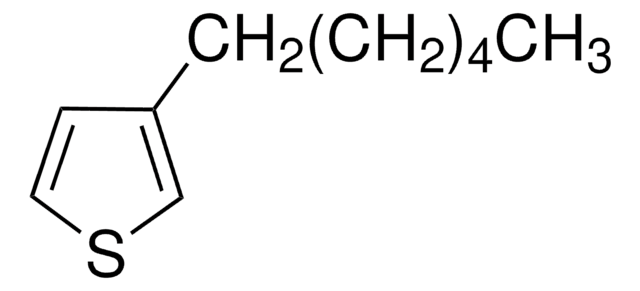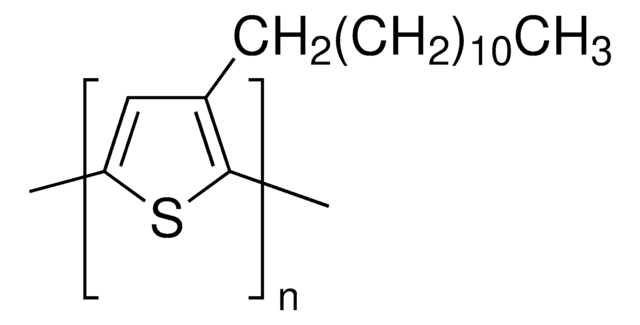900563
Poly(3-hexylthiophene-2,5-diyl)
regioregular, average Mw 20,000-45,000
Sinonimo/i:
P3HT
About This Item
Prodotti consigliati
Descrizione
Metal purity: Mg: ≤100 ppm
Ni: ≤100 ppm
Regioregularity: ≥90%
Livello qualitativo
Stato
solid
PM
average Mw 20,000-45,000
Stringa SMILE
[s]1c(c(cc1C)CCCCCC)C
InChI
1S/C12H20S/c1-4-5-6-7-8-12-9-10(2)13-11(12)3/h9H,4-8H2,1-3H3
DUFPJSOXRHVDOV-UHFFFAOYSA-N
Cerchi prodotti simili? Visita Guida al confronto tra prodotti
Categorie correlate
Descrizione generale
Applicazioni
- Active semiconductor to prepare organic field emission transistors. In regioregular P3HT the microcrystalline domains are well constructed by phase-segregated layers of insulating alkali side chains and pi-pi interchain stacking. This leads to high charge mobility and enhances the performance of OFETs.
- Precursor to synthesize P3HT-PCBM( [6,6]-phenyl C61-butyric acid methyl ester) blend thin film. The highcrystallinity of P3HT thin film increases the efficiency of organicphotovoltaic cells.
Codice della classe di stoccaggio
11 - Combustible Solids
Classe di pericolosità dell'acqua (WGK)
WGK 3
Punto d’infiammabilità (°F)
Not applicable
Punto d’infiammabilità (°C)
Not applicable
Scegli una delle versioni più recenti:
Certificati d'analisi (COA)
Non trovi la versione di tuo interesse?
Se hai bisogno di una versione specifica, puoi cercare il certificato tramite il numero di lotto.
Possiedi già questo prodotto?
I documenti relativi ai prodotti acquistati recentemente sono disponibili nell’Archivio dei documenti.
I clienti hanno visto anche
Articoli
Professor Shinar (Iowa State University, USA) summarizes the developments of a variety of sensor configurations based on organic and hybrid electronics, as low-cost, disposable, non-invasive, wearable bioelectronics for healthcare.
Intrinsically stretchable active layers for organic field-effect transistors (OFET) are discussed. Polymer structural modification & post-polymerization modifications are 2 methods to achieve this.
Next generation solar cells have the potential to achieve conversion efficiencies beyond the Shockley-Queisser (S-Q) limit while also significantly lowering production costs.
Dr. Perini and Professor Correa-Baena discuss the latest research and effort to obtain higher performance and stability of perovskite materials.
Global Trade Item Number
| SKU | GTIN |
|---|---|
| 900563-1G | 4061824484618 |
| 900563-5G | 4061832989501 |
Il team dei nostri ricercatori vanta grande esperienza in tutte le aree della ricerca quali Life Science, scienza dei materiali, sintesi chimica, cromatografia, discipline analitiche, ecc..
Contatta l'Assistenza Tecnica.



![[6,6]-Phenyl C61 butyric acid methyl ester ≥99%](/deepweb/assets/sigmaaldrich/product/structures/359/221/d990c746-0960-4c69-bf76-fe09b193824d/640/d990c746-0960-4c69-bf76-fe09b193824d.png)

![[6,6]-Phenyl C71 butyric acid methyl ester 99%](/deepweb/assets/sigmaaldrich/product/structures/716/624/9fb9f2f0-ae99-429f-8d3a-b12267976a4d/640/9fb9f2f0-ae99-429f-8d3a-b12267976a4d.png)


